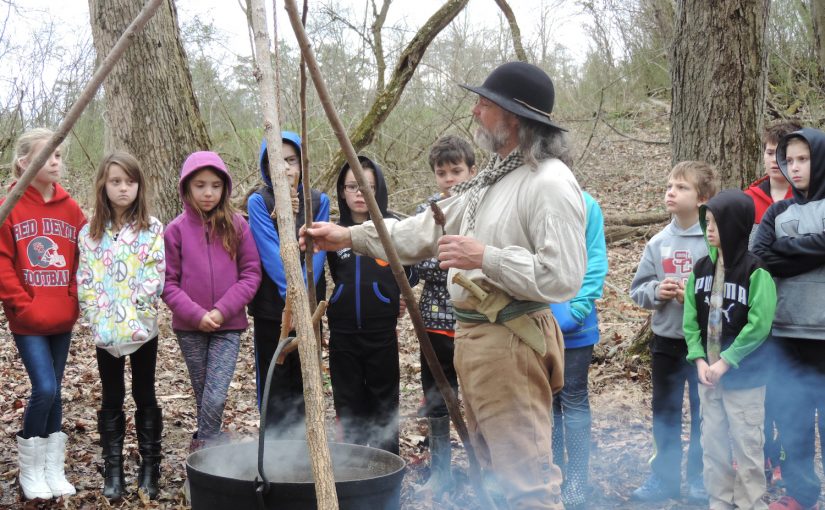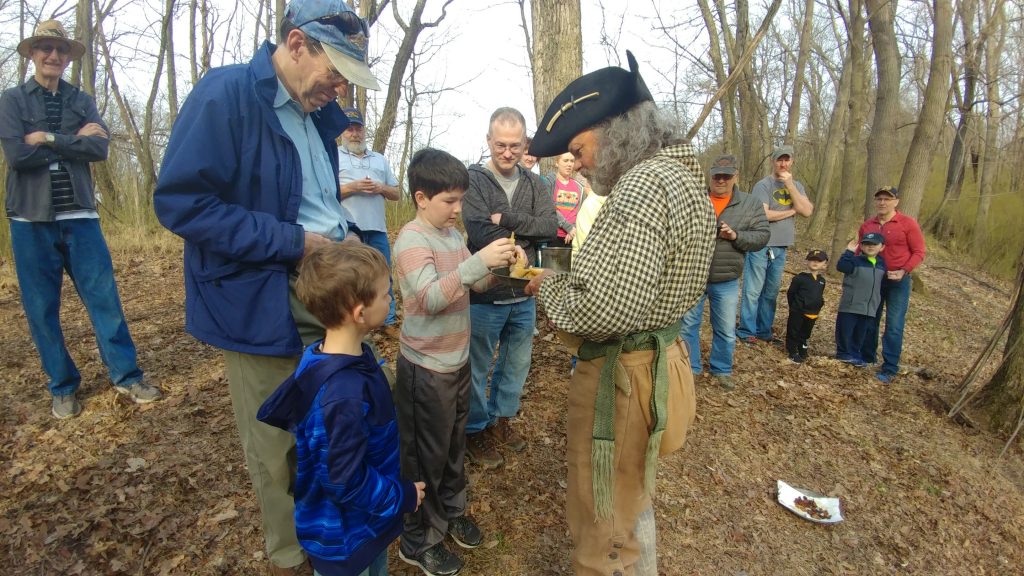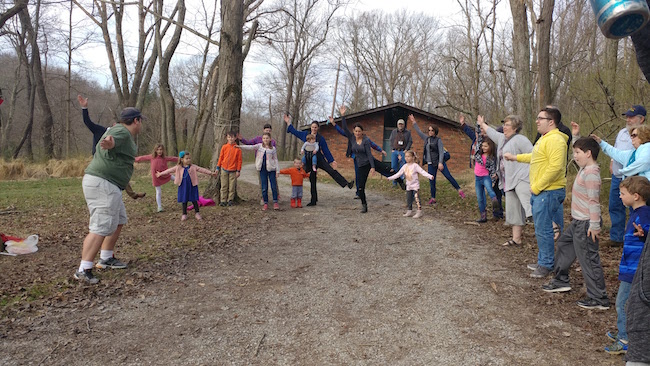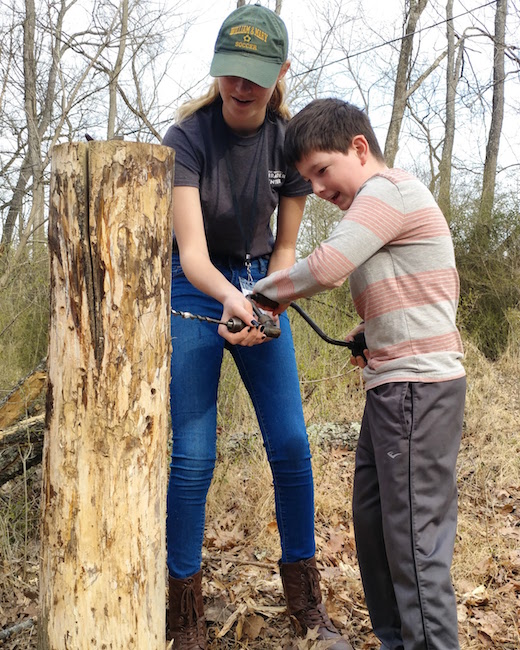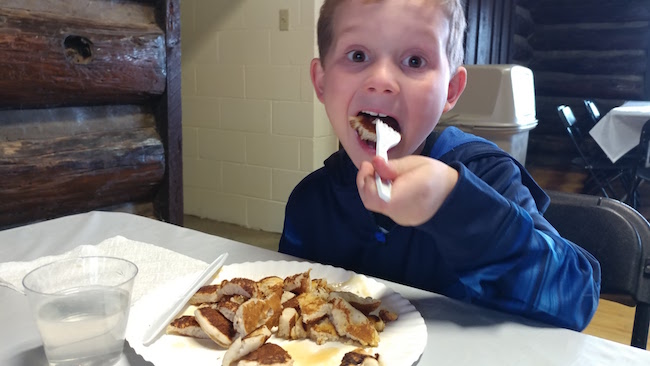By Laura Jackson Roberts
Oglebay Institute stands on innovation and tradition. Every season, you’ll find both new classes and events as well as those you’ve come to enjoy for years. Of all the OI traditions I’ve participated in, none seem so beloved as the annual Maple Sugaring Day at Camp Russel in Oglebay Park. I didn’t discover the event until I was an adult, and by that time, friends had been attending for years. I see familiar faces every time I go.
My kids often begin their weekend in their pajamas, zombified by the screens on their tablets. Today, though, they’re up early and find a patch of mud in the parking lot before we’ve even locked the car. We’re in the first tour group this morning, and the woods are still quiet. Inside Camp Russel’s main building, the employees of Oglebay Institute Schrader Environmental Center welcome us. We can hear the breakfast preparations in the kitchen, and there’s a mini-Samara Shop set up with local craft and nature items for sale: books, mugs, jewelry, and a singing cardinal stuffed animal my younger son zeroes in on right away.
Take a Walk in the Woods
But it’s time for the tour, and our group meets outside for the introduction. We’ll be going through a series of stations on our walk this morning, and Schrader educator Robin Lee points us in the direction of our first stop, where we gather around a fire and learn the early history of maple sugaring. Native Americans knew the secret of the sweet sap long before Europeans arrived. They heated igneous rocks to boil the water out of the sap, leaving behind the maple syrup. Native Americans knew that the hard work of sap collection produced the best rewards.
Discover Pioneer Methods of Maple Sugaring
At our next stop, we meet a colonial man and his wife. He explains that Thomas Jefferson sent pioneers from Virginia to bring back the sugar maple tree to Monticello, thereby eliminating the need to buy sugar from the British. Pioneers learned to watch for the arrival of the yellow-bellied sapsucker as a harbinger of the season’s start. Alas, Virginia proved a poor climate for maple sugar production, and Thomas Jefferson had to eat his pancakes dry.
My first Maple Sugaring Day was a frigid one; this time, the March wind has blown in at a comfortable 65 degrees. This year is warm, the colonial man tells us, which isn’t a good thing for the sugar maples.
“Weather is the key,” he says, as his overworked wife kneels on the ground, in character, grumbling about her cast iron skillet duties. The kids sample bacon and sourdough bread cooked on the fire.
Learn About Sugar Maples
Next, we learn the botanical mechanics of the sugar maple tree, and the Schrader educators confirm that this weird, warm winter has adversely affected the sap. Our balmy February means that maple syrup does not runneth over this year. The hardworking chefs in the kitchen may have to supplement breakfast with syrup from another local farm. It takes 320 gallons of sugar maple sap to produce only one gallon of syrup.
Try Your Hand at Tapping Trees
At the tapping station, the kids, who have all been enjoying this morning in the woods whether they’ve been listening to the speakers (most children) or swashbuckling with sharp sticks (my children), get a chance to tap a tree themselves. A Schrader educator hands my older son an old-fashioned hand drill and a steel spile (the tap), and he practices on a stump. Every kid gets a turn to drill and pound and dirty their hands. This is why they’ve come to the woods, isn’t it? Whether my kids come home with knowledge or a deer skull they find in the woods (they will name it Bart), they’re having an experience out here. Maple Sugaring Day doesn’t judge.
As we walk through the woods back to Camp Russel, we pass a sugar maple grove. The trees are all tapped. I walk this path often in warmer months and rarely take note of the sugar maples I pass. In fact, I’m not sure I could pick one out of a deciduous tree lineup. We’re all surprised at how many of them grow along the trail. Steel buckets and plastic collection bags hang from each tree, and the Schrader folks tell us the season is about over. Time to gather that sap and make something delicious.
Watch Syrup Being Made and Eat Pancakes, Too!
The smell of pancakes and sausage wafts out over the lawn, but before we return to our waiting breakfast, we stop at the boiling station. Here, Hugh Hyre, owner of Misty Mountain Estate in Lewisville, Ohio, demonstrates the modern way of doing things. No hot rocks, no angry colonial wench tending to a cast iron pot. The sap is boiling nicely in a stainless steel evaporator as he takes us through the process.
I never find out exactly how it’s done, though, because Benjamin, my youngest, is starving and wanders off. I find him in the dining room, the first in line, holding up his plate as the ladies in the kitchen pile it with a stack of pancakes and two sausage links. By the time the rest of the family finds their way to the pancake line, Ben has scarfed his breakfast and fallen into a food coma, head on the sticky tablecloth.
I’d call Maple Sugaring Day a wrap.
Go & Do
Oglebay Institute’s Maple Sugaring Day 2018 is Saturday, March 17. Tours begin at 9am and continue every half hour with the last group leaving at 12:30pm. Make reservations in advance, the event typically sells out. Find out more online or by calling 304-242-6855.

